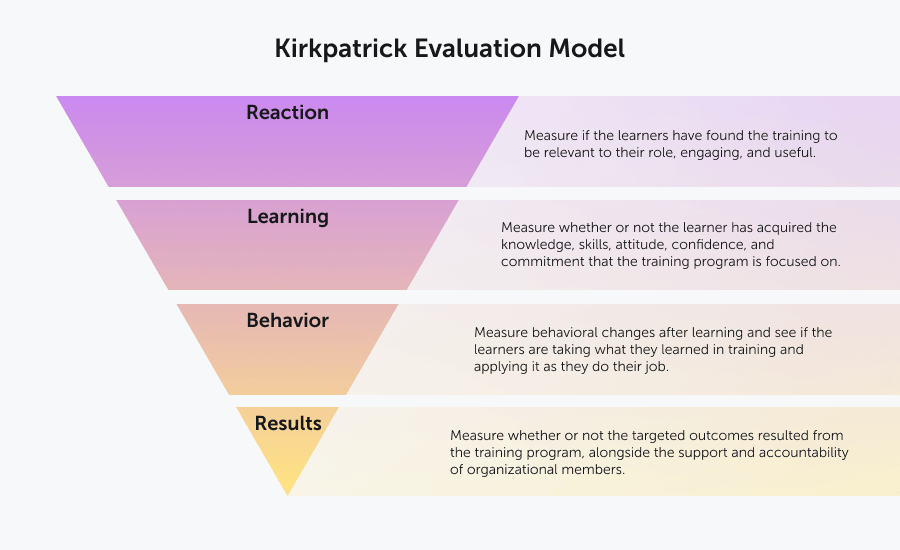Kirkpatrick Model? Become familiar with the 4 Degrees of Assessment

In the realm of training and development, evaluating the effectiveness of learning programs is crucial for continuous improvement and optimal results. One widely recognized framework for assessing training outcomes is the Kirkpatrick Model, developed by Donald L. Kirkpatrick. This model has become a cornerstone in the field, offering a structured approach to measure the impact of training at four distinct levels.
The Four Degrees of Assessment
-
Level 1: Reaction
The first degree of the Kirkpatrick Model focuses on participants’ reactions to the training program. This level assesses the immediate response and satisfaction of learners. It involves gathering feedback on various aspects, including the content, delivery, and overall experience.
To effectively gauge participants’ reactions, trainers often use surveys, questionnaires, or interviews. Questions may revolve around the relevance of the content, the quality of the instructors, and the perceived value of the training. This feedback is valuable for making quick adjustments to improve the overall training experience and address any concerns that may arise.
Level 1 assessments provide insights into the engagement and motivation of participants. Positive reactions can indicate a well-designed and engaging program, while negative feedback may signal areas for improvement. However, it’s essential to note that positive reactions do not guarantee that learning has occurred or that the training will translate into improved performance.
-
Level 2: Learning
Moving beyond immediate reactions, Level 2 of the Kirkpatrick Model assesses the actual learning that takes place during the training program. This involves evaluating the participants’ knowledge acquisition, skills development, and changes in attitude.
To measure learning, assessments can include quizzes, tests, skill demonstrations, or other methods tailored to the specific objectives of the training. Pre-and post-training evaluations can help determine the knowledge gained and skills acquired by participants. Additionally, observation and self-assessment may be employed to provide a more comprehensive understanding of the learning outcomes.
Level 2 assessments enable organizations to determine the effectiveness of the training content and instructional methods. Positive results indicate that participants have acquired the intended knowledge and skills, providing a foundation for subsequent levels of assessment.
-
Level 3: Behavior
The third level of the Kirkpatrick Model focuses on behavioral changes exhibited by participants as a result of the training. This level is concerned with assessing whether the newly acquired knowledge and skills are being applied in the workplace.
Behavioral changes can manifest in various ways, such as improved job performance, changes in work habits, or the application of new skills in daily tasks. Measuring these changes often involves collecting data through observations, performance evaluations, and feedback from supervisors or peers.
Level 3 assessments provide organizations with valuable insights into the practical impact of the training on participants’ behavior. Positive outcomes suggest that the training has successfully translated into improved on-the-job performance, contributing to the overall effectiveness of the learning program.
-
Level 4: Results
The ultimate goal of any training program is to achieve positive organizational results. Level 4 of the Kirkpatrick Model focuses on assessing the broader impact of training on business objectives and outcomes. This level explores the link between training investments and tangible benefits for the organization.
Organizational results may include improved productivity, increased sales, enhanced customer satisfaction, or other key performance indicators relevant to the specific goals of the training program. Measuring these results requires a comprehensive analysis of data, often over an extended period, to determine the long-term impact of the training initiative.
Level 4 assessments provide organizations with a holistic view of the return on investment (ROI) for their training efforts. By establishing a clear connection between training outcomes and organizational results, decision-makers can make informed choices about future training initiatives and resource allocation.
Challenges and Considerations
While the Kirkpatrick Model provides a robust framework for assessing training effectiveness, it’s important to acknowledge some challenges and considerations associated with its implementation.
One challenge is the time and resources required for comprehensive assessments at all four levels. Organizations may face constraints in collecting data over an extended period or conducting in-depth analyses of organizational results. Striking a balance between thorough evaluation and practical feasibility is essential.
Another consideration is the need for alignment between training objectives and organizational goals. To effectively measure results (Level 4), organizations must define clear objectives and ensure that training outcomes directly contribute to these broader goals. This alignment ensures that the evaluation process is meaningful and actionable.
Conclusion
The Kirkpatrick Model offers a systematic and comprehensive approach to assessing training effectiveness at four distinct levels. By evaluating reactions, learning, behavior, and results, organizations can gain valuable insights into the impact of their training programs. This model provides a roadmap for continuous improvement, enabling organizations to refine their training initiatives and enhance overall performance. As the landscape of training and development evolves, the Kirkpatrick Model remains a valuable tool for organizations committed to maximizing the impact of their learning programs.





